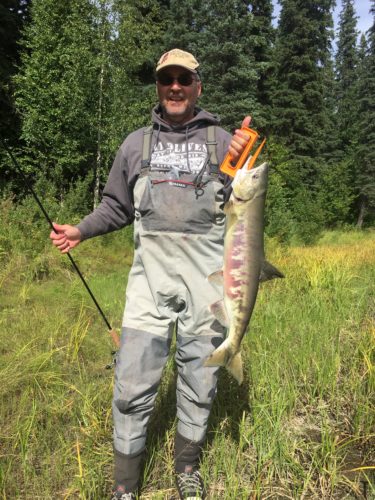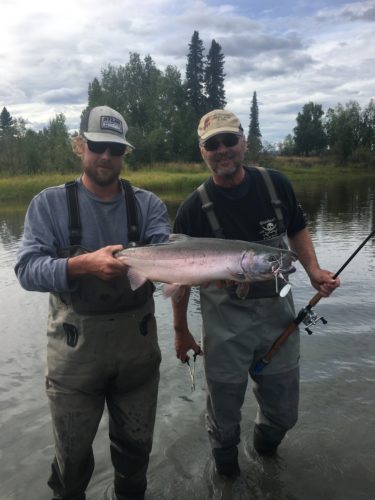An Alaskan Salmon Welcome ‘Mat’
The following appears in the July issue of Alaska Sporting Journal:

BY BRIAN KELLY
Alaska’s Matanuska-Susitna Valley – locally known as the “Mat-Su” – has long been a tourist hub for those heading to Denali National Park to get a glimpse of its majestic mountain.
While a visit to Denali is a worthy trip on its own, visiting anglers should take advantage of the world-class salmon fishing in the area. Whether you travel by road or by air, there are plenty of river systems to access.
ROAD SYSTEM BASICS
The Mat-Su road system is a fairly easy jaunt from Anchorage. Take the Glenn Highway north to the Parks Highway north and the fun begins. Wasilla tends to be our group’s headquarters when visiting the Mat-Su, as there are ample accommodations available around town.
The stretch of the Parks Highway from Wasilla to Talkeetna should be the focus for the traveling angler; there are as many as a dozen tributaries of the Susitna River along this route, along with the hallowed banks of the Little Susitna River. Sheep Creek, Fish Creek, Willow Creek and Montana Creek are the most popular along this stretch, as they have easy access along the road with trails to take adventurous anglers down to where many of these streams meet the Susitna. While the Susitna is a glacier-fed system – with limited visibility – the aforementioned creeks are spring-fed and clear-flowing, and they offer resting places for salmon as they migrate up the Big Su.
SALMON BONANZA
While all five Pacific salmon species are available along the road system, the Chinook run is managed closely by Alaska Department of Fish and Game and tends to be closed or limited to catch and release with single-hook artificial- only lures. Be sure to check ADFG’s website (adfg.alaska.gov), where emergency fishing orders are posted based on run strength or weakness.
My humble advice after traveling to this region for over a decade would be to pass on Chinook and focus on the other species, namely coho (silver), chums and pinks, as these species are far more prolific in tributaries along the road system.
Run timing can vary from stream to stream, but typically the chums and pinks will show up in early July and carry into mid-August most years. Both species aren’t shy biters, so the usual assortment of flies, spinners and jigs will keep you busy most days. But if you are there when the chums pile in thick, try using a piece of shrimp under a float; itwillbeallyoucandotokeepabaitin the water some days!
Silvers begin to make their presence known along the road system throughout the month of August. The local pressure can be substantial during the early part of the month but tends to thin out in mid- to late-August as schools reopen and local hunting seasons open, which can lead to empty streams and lots of eager silvers.
Drifting eggs under a float is by far the most popular technique and is often so effective that ADFG will ban the use of bait if the run counts are low. But the beauty of silver salmon is that they will readily take a variety of techniques – from spinners and jigs to swung Bunny Leeches on a fly rod.
Our group’s favorite technique is twitching jigs; we call them the “fish finder” because even if silvers don’t hit them on the retrieve, they will oftentimes follow a twitched jig, which lets you know the fish are there!

FLY OUT FOR FAST ACTION
The western side of the Mat-Su is only accessible by float plane and offers the remote Alaskan experience without the hassle of multiple flights to reach your destination. While there are many lodges spread out on the west side of the valley, a trip with Big Dave Manners is highly recommended. Located on the banks of the Kichatna River, Big Dave’s Alaskan Bush Lodge (bigdavefishing.com) is only a 45-minute flight from Anchorage.
No sooner than you land on the river, the guides will have you on the water, and a prime stretch lies within a short jet sled ride from camp. As with the Big Su, the mainstem Kichatna is a typical low- visibility and muddy glacier-fed river with a series of spring-fed feeder streams that are loaded with silvers.
When we fished here, we were amazed at how bright the salmon were this far from the ocean. While we did have to pick through some blush fish, there was no lack of chrome-sided silvers bearing bright orange fillets!
Dave’s team of guides had the clients on a daily rotation, so we weren’t just fishing the same creek mouth every day. Some mornings, we would pull into a creek mouth and the backs of the fish would be poking out of the water. These were the times you could apply any popular technique and hook fish until your shoulder was burning.
While the morning bite was always good, the afternoons would light up as well. As with any situation, there are just times when the fish pile into an area in the middle of the day and our guides were clued into sled ride from camp. As with the Big Su, the mainstem Kichatna is a typical low- visibility and muddy glacier-fed river with a series of spring-fed feeder streams that are loaded with silvers.
When we fished here, we were amazed at how bright the salmon were this far from the ocean. While we did have to pick through some blush fish, there was no lack of chrome-sided silvers bearing bright orange fillets!
Dave’s team of guides had the clients on a daily rotation, so we weren’t just fishing the same creek mouth every day. Some mornings, we would pull into a creek mouth and the backs of the fish would be poking out of the water. These were the times you could apply any popular technique and hook fish until your shoulder was burning.
While the morning bite was always good, the afternoons would light up as well. As with any situation, there are just times when the fish pile into an area in the middle of the day and our guides were clued into which creek mouths were fishing best. The typical assortment of Vibrax spinners were usually deployed, but our group brought along some pink Arctic Spinners that we buzzed just under the surface, which made for some awesome takes, as two or three salmon would come out of nowhere to inhale our offerings.

A GORGEOUS SETTING
While the fishing and home-cooked meals were off the charts, the scenery was truly breathtaking on the days when the skies parted. To be able to see the peaks of Mount Denali and Mount Foraker on the boat ride back to camp is something special. I will always cherish the memories of my adventure to this special place.
The Mat-Su Valley will always hold a special place in my little salmon angler heart, as I landed my first Alaskan silver on the banks of the Little Susitna River many years ago. While there are so many options for the salmon angler in the state of Alaska, the Mat-Su does have it all; from small spring creeks to wide-flowing glacier-fed rivers, the options are endless, and the scenery is something you will never forget. ASJ



